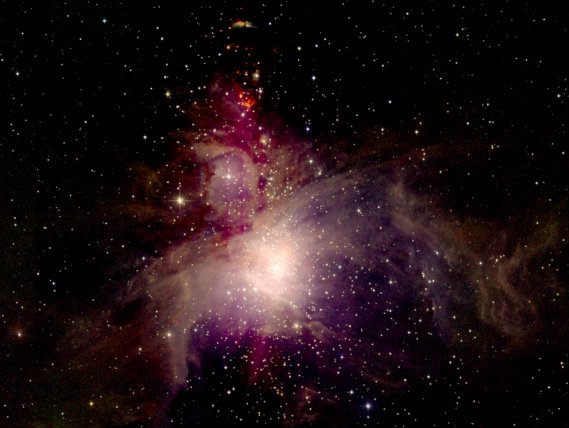
|
Explanation: Few astronomical sights excite the imagination like the nearby stellar nursery known as the Orion Nebula. The Nebula's glowing gas surrounds hot young stars at the edge of an immense interstellar molecular cloud only 1,500 light-years away. This distinctively detailed image of the Orion Nebula was constructed using data from the 2 Micron All Sky Survey or 2MASS. Using telescopes in the Northern and Southern Hemispheres of planet Earth, the 2MASS project has mapped the entire sky in infrared light. The wavelength of infrared light is longer than visible light but more easily penetrates obscuring dust clouds. 2MASS cameras were sensitve to near infrared wavelengths around 2 microns or about 0.00008 inches. Visible light has a wavelength of about 0.00002 inches. Survey observations in three infrared bands were translated to blue, green, and red colors to produce this composite image.
|
January February March April May June July August September October November December |
| ||||||||||||||||||||||||||||||||||||||||||||||||
NASA Web Site Statements, Warnings, and Disclaimers
NASA Official: Jay Norris. Specific rights apply.
A service of: LHEA at NASA / GSFC
& Michigan Tech. U.
Based on Astronomy Picture
Of the Day
Publications with keywords: Orion Nebula - emission nebula - star formation - infrared
Publications with words: Orion Nebula - emission nebula - star formation - infrared
See also:
- APOD: 2025 December 9 B The Heart of the Soul Nebula
- Orion and the Running Man
- APOD: 2025 September 19 B The NGC 6914 Complex
- APOD: 2025 September 10 B The Great Lacerta Nebula
- APOD: 2025 August 13 B Trapezium: In the Heart of Orion
- APOD: 2025 July 21 B Cats Paw Nebula from Webb Space Telescope
- APOD: 2025 July 16 B The Rosette Nebula from DECam
